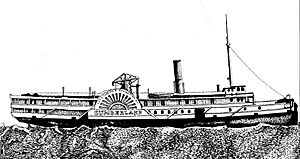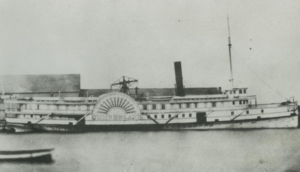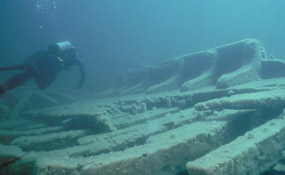PS Cumberland facts for kids
 |
|
Quick facts for kids History |
|
|---|---|
| Name | Cumberland |
| Operator | Toronto and Lake Superior Navigation Company |
| Builder | Melanchthan & Simpson |
| Launched | August 8, 1871 |
| Fate | Sank 1877 |
| General characteristics | |
| Type | Side paddlewheeler |
| Tonnage | 750 tons gross |
| Length | 214 feet |
| Beam | 28 feet |
| Draft | 10.5 feet |
| Installed power | 400HP |
| Propulsion | walking beam engine |
|
CUMBERLAND
|
|
| Location | Near Rock of Ages Light, Isle Royale National Park, Michigan |
| Area | 206.6 acres (83.6 ha) |
| Built | 1871 |
| Architect | Melanchthan & Simpson |
| Architectural style | Side paddlewheeler |
| MPS | Shipwrecks of Isle Royale National Park TR |
| NRHP reference No. | 84001732 |
| Added to NRHP | June 14, 1984 |
The Cumberland was a large wooden ship built in 1871. It was a "side paddlewheeler," meaning it moved through the water using big wheels on its sides, like a steamboat. This ship sank in Lake Superior in 1877 near Isle Royale. Today, its remains are still at the bottom of the lake. The wreck was added to the National Register of Historic Places in 1984 because it's an important historical site.
Contents
Ship's History and Design
The Cumberland was built in 1871 by Melanchthan & Simpson in Port Robinson, Ontario. It was made for Perry & Company, a shipping line in Toronto. The ship was launched on August 8, 1871.
The Cumberland's design was common for sidewheel steamers built for the Great Lakes between the 1840s and 1880s. It was a wooden ship with paddlewheels on its sides. The ship was 214 feet long and 28 feet wide. It weighed 750 tons and needed 10 feet 6 inches of water to float. A 400-horsepower engine powered the ship, which had one boiler and paddlewheels 30 feet across.
The Cumberland was built for the Northern Railway of Canada. This company owned the Toronto and Lake Superior Navigation Company. The ship was meant to travel between Duluth, Minnesota and Collingwood or Owen Sound, Ontario. It was named after Fred W. Cumberland, who was the general manager of the Northern Railway. The ship began its service in May 1871.
Challenges and Incidents
During its time in service, the Cumberland faced several serious problems.
- In November 1872, the ship got stuck in ice on the St. Mary's River. Most of the crew walked from the ship to Collingwood, Ontario. A few crew members and passengers stayed on the vessel. It is thought the ship stayed frozen in the ice until spring.
- In November 1874, the Cumberland was caught in a storm while heading to Thunder Bay. The material sealing the ship's hull, called "caulking," came loose. Water began to leak into the ship. To make the ship lighter, some cargo was removed from the deck. The ship managed to reach port with six feet of water inside. It then sank at the dock.
- In November 1875, the Cumberland was again caught in a storm. It ran aground (got stuck on the bottom) near Silver Islet, Ontario. Luckily, the ship was not badly damaged. The cargo and passengers soon arrived safely in Thunder Bay.
- In September 1876, the ship ran aground once more. This time, it happened at Owen Sound.
The Sinking of the Cumberland
In July 1877, the Cumberland was stuck on a sandbar in the harbor at Nipigon for three days. It arrived in Thunder Bay on July 24, which was three days later than planned. The ship likely left Thunder Bay the same day. However, once it was out of port, it started taking on water.
The day was clear and dry. Passengers were moved safely to another ship. On July 25, 1877, the Cumberland hit a reef near the Rock of Ages Light. The front part of the ship got stuck firmly on the ground. Other ships tried to pull the Cumberland free, but it was stuck fast.
People tried to save the ship and its parts, using tugboats and other vessels. However, the wreck was quickly falling apart. By August 12, efforts to save it were stopped. The ship completely broke apart on August 18. Parts of it could be seen for several weeks, but the ship was fully underwater by early September.
The Cumberland Wreck Today
Large parts of the ship still remain underwater. They are found in water that is 20 to 80 feet deep. These parts include the wooden hull, one of the side-wheels, and the boiler. However, most of the upper parts of the ship are gone. Also, almost all of the engine is missing.
The remains of the Cumberland are mixed with some parts of the hull of the Henry Chisholm. The Henry Chisholm sank later in 1898. The Cumberland wreck is also not far from the remains of the George M. Cox.
In 2009, about 40 dives were made to the Cumberland wreck. This was out of 1062 dives made to all the wrecks in the Isle Royale National Park. The Cumberland is important because it is the only known shipwreck of its size, style, and age in Lake Superior.





